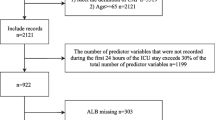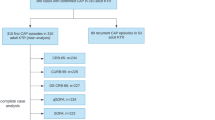Abstract
Background
The prognosis of pneumonia in patients with advanced stage chronic kidney disease (CKD) remains unimproved for years. We attempt to develop a simple and more useful scoring system for predicting in-hospital mortality for advanced CKD patients with pneumonia.
Methods
Using the Diagnosis Procedure Combination database, we identified the in-hospital adult patients both with a record of pneumonia and stage 5 or 5D CKD as a comorbidity on admission between April 1, 2012 and March 31, 2016. Predictive variable selection was analyzed by multivariable logistic regression analysis, stepwise method, LASSO method and random forest method, and then develop a new simple scoring system seeking for highest c-statistics combination of variables in one sample data set for model development. Finally, we compared c-statistics of univariate logistic regression about new scoring system with c-statistics about “A-DROP” in the other sample data set.
Result
We identified 8402 patients in 707 hospitals, and the total in-hospital mortality was 11.0% (437 patients) in development data set. Seven variables were selected, which includes age (male ≥ 70 years, female ≥ 75 years), respiratory failure, orientation disturbance, low blood pressure, the need of assistance in feeding or bowel control, severe or moderate thinness and CRP 200 mg/L or extent of consolidation on chest X-ray ≥ 2/3 of one lung. The c-statistics of univariate logistic regression was 0.8017 using seven variables, while that was 0.7372 using “A-DROP”
Conclusion
In advanced CKD patients, if we select appropriate variables for predicting in-hospital mortality, simple scoring system may have better discrimination than “A-DROP”.




Similar content being viewed by others
References
James MT, Quan H, Tonelli M, Manns BJ, Faris P, Laupland KB, et al. CKD and risk of hospitalization and death with pneumonia. Am J Kidney Dis. 2009;54(1):24–322. https://doi.org/10.1053/j.ajkd.2009.04.005.
Wakasugi M, Kazama JJ, Narita I. Mortality trends among Japanese dialysis patients, 1988–2013: a joinpoint regression analysis. Nephrol Dial Transplant. 2016;31(9):1501–7. https://doi.org/10.1093/ndt/gfw249.
Wetmore JB, Li S, Molony JT, Guo H, Herzog CA, Gilbertson DT, et al. Insights from the 2016 peer kidney care initiative report: still a ways to go to improve care for dialysis patients. Am J Kidney Dis. 2018;71(1):123–32. https://doi.org/10.1053/j.ajkd.2017.08.023.
Wakasugi M, Kawamura K, Yamamoto S, Kazama JJ, Narita I. High mortality rate of infectious diseases in dialysis patients: a comparison with the general population in Japan. Ther Apher Dial. 2012;16(3):226–31. https://doi.org/10.1111/j.1744-9987.2012.01062.x.
Lim WS, van der Eerden MM, Laing R, Boersma WG, Karalus N, Town GI, et al. Defining community acquired pneumonia severity on presentation to hospital: an international derivation and validation study. Thorax. 2003;58(5):377–82.
Shindo Y, Sato S, Maruyama E, Ohashi T, Ogawa M, Imaizumi K, et al. Comparison of severity scoring systems A-DROP and CURB-65 for community-acquired pneumonia. Respirology (Carlton, Vic). 2008;13(5):731–5. https://doi.org/10.1111/j.1440-1843.2008.01329.x.
Uematsu H, Kunisawa S, Sasaki N, Ikai H, Imanaka Y. Development of a risk-adjusted in-hospital mortality prediction model for community-acquired pneumonia: a retrospective analysis using a Japanese administrative database. BMC Pulm Med. 2014;14:203. https://doi.org/10.1186/1471-2466-14-203.
Kunisawa S, Fushimi K, Imanaka Y. Reducing length of hospital stay does not increase readmission rates in early-stage gastric, colon, and lung cancer surgical cases in japanese acute care hospitals. PLoS ONE. 2016;11(11):e0166269. https://doi.org/10.1371/journal.pone.0166269.
Matsunuma R, Asai N, Ohkuni Y, Nakashima K, Iwasaki T, Misawa M, et al. I-ROAD could be efficient in predicting severity of community-acquired pneumonia or healthcare-associated pneumonia. Singapore Med J. 2014;55(6):318–24.
World Health Organization. Global database on body mass index. https://www.assessmentpsychology.com/icbmi.htm. Accessed 3 Sep 2019.
Mahoney FI, Barthel DW. Functional evaluation: the Barthel index. Md State Med J. 1965;14:61–5.
Takada D, Kunisawa S, Fushimi K, Imanaka Y. Previously-initiated hemodialysis as prognostic factor for in-hospital mortality in pneumonia patients with stage 5 chronic kidney disease: retrospective database study of Japanese hospitals. PLoS ONE. 2019;14(2):e0213105. https://doi.org/10.1371/journal.pone.0213105.
Ambler G, Brady AR, Royston P. Simplifying a prognostic model: a simulation study based on clinical data. Stat Med. 2002;21(24):3803–22. https://doi.org/10.1002/sim.1422.
Tibshirani R. The lasso method for variable selection in the Cox model. Stat Med. 1997;16(4):385–95.
Pavlou M, Ambler G, Seaman SR, Guttmann O, Elliott P, King M, et al. How to develop a more accurate risk prediction model when there are few events. BMJ (Clin Res ed). 2015;351:h3868. https://doi.org/10.1136/bmj.h3868.
Kruppa J, Liu Y, Biau G, Kohler M, Konig IR, Malley JD, et al. Probability estimation with machine learning methods for dichotomous and multicategory outcome: theory. Biom J. 2014;56(4):534–63. https://doi.org/10.1002/bimj.201300068.
Breiman L. Random forests. Mach Learn. 2001;45(1):5–32.
Speiser JL, Durkalski VL, Lee WM. Random forest classification of etiologies for an orphan disease. Stat Med. 2015;34(5):887–99. https://doi.org/10.1002/sim.6351.
Calle ML, Urrea V. Letter to the editor: stability of random forest importance measures. Brief Bioinform. 2011;12(1):86–9. https://doi.org/10.1093/bib/bbq011.
Peduzzi P, Concato J, Feinstein AR, Holford TR. Importance of events per independent variable in proportional hazards regression analysis. II. Accuracy and precision of regression estimates. J Clin Epidemiol. 1995;48(12):1503–10. https://doi.org/10.1016/0895-4356(95)00048-8.
Hosmer DW. Applied Logistic Regression Third Edition. Wiley-Blackwell Online Books. 2013.
Wolpert DH, Macready WG. No free lunch theorems for optimization. IEEE Trans Evol Comput. 1997;1(1):67–82. https://doi.org/10.1109/4235.585893.
Ramos LR, Simoes EJ, Albert MS. Dependence in activities of daily living and cognitive impairment strongly predicted mortality in older urban residents in Brazil: a 2-year follow-up. J Am Geriatr Soc. 2001;49(9):1168–75.
Scott WK, Macera CA, Cornman CB, Sharpe PA. Functional health status as a predictor of mortality in men and women over 65. J Clin Epidemiol. 1997;50(3):291–6.
Mlinac ME, Feng MC. Assessment of Activities of Daily Living, Self-Care, and Independence. Arch Clin Neuropsychol. 2016;31(6):506–16. https://doi.org/10.1093/arclin/acw049.
Giebel CM, Sutcliffe C, Challis D. Activities of daily living and quality of life across different stages of dementia: a UK study. Aging Ment Health. 2015;19(1):63–71. https://doi.org/10.1080/13607863.2014.915920.
Nie W, Zhang Y, Jee SH, Jung KJ, Li B, Xiu Q. Obesity survival paradox in pneumonia: a meta-analysis. BMC Med. 2014;12:61. https://doi.org/10.1186/1741-7015-12-61.
Atamna A, Elis A, Gilady E, Gitter-Azulay L, Bishara J. How obesity impacts outcomes of infectious diseases. Eur J Clin Microbiol Infect Dis. 2017;36(3):585–91. https://doi.org/10.1007/s10096-016-2835-1.
Ma L, Zhao S. Risk factors for mortality in patients undergoing hemodialysis: a systematic review and meta-analysis. Int J Cardiol. 2017;238:151–8. https://doi.org/10.1016/j.ijcard.2017.02.095.
American Thoracic Society, et al. Guidelines for the management of adults with hospital-acquired, ventilator-associated, and healthcare-associated pneumonia. Am J Respir Crit Care Med. 2005;171(4):388–416. https://doi.org/10.1164/rccm.200405-644ST.
Azur MJ, Stuart EA, Frangakis C, Leaf PJ. Multiple imputation by chained equations: what is it and how does it work? Int J Methods Psychiatr Res. 2011;20(1):40–9. https://doi.org/10.1002/mpr.329.
Acknowledgements
We thank all the staff members at all the participating acute care hospitals.
Funding
This work was funded by the Ministry of Health, Labour and Welfare (Grant number H27-iryo-ippan-001, H30-seisaku-shitei-004); Grant-in-Aid for Scientific Research from the Japan Society for the Promotion of Science (Grant number 16H02634, 19H01075).
Author information
Authors and Affiliations
Contributions
Research idea and study design: DT, SK, TM, MY, and YI; data analysis/interpretation: DT, SK, and YI; data acquisition: DT, SK, KF, and YI; statistical analysis: DT and YI. Each author contributed important intellectual content during manuscript drafting or revision, accepts personal accountability for the author’s own contributions, and agrees to ensure that questions pertaining to the accuracy or integrity of any portion of the work are appropriately investigated and resolved.
Corresponding author
Ethics declarations
Conflict of interest
Potential financial conflicts of interest, Honoraria: Motoko Yanagita (Chugai Pharmaceutical, Kyowa Kirin).
Ethical approval
The study protocol was approved by the ethics committee of Kyoto University Graduate School and the Faculty of Medicine (approval number: R0135). This study was conducted in accordance with the ethical guidelines for medical and health research involving human participants issued by the Japanese National Government. These guidelines include a stipulation for the protection of patient anonymity.
Informed consent
The data were anonymized, and the requirement for informed consent was waived.
Additional information
Publisher's Note
Springer Nature remains neutral with regard to jurisdictional claims in published maps and institutional affiliations.
About this article
Cite this article
Takada, D., Kunisawa, S., Matsubara, T. et al. Developing and validating a multivariable prediction model for in-hospital mortality of pneumonia with advanced chronic kidney disease patients: a retrospective analysis using a nationwide database in Japan. Clin Exp Nephrol 24, 715–724 (2020). https://doi.org/10.1007/s10157-020-01887-8
Received:
Accepted:
Published:
Issue Date:
DOI: https://doi.org/10.1007/s10157-020-01887-8




